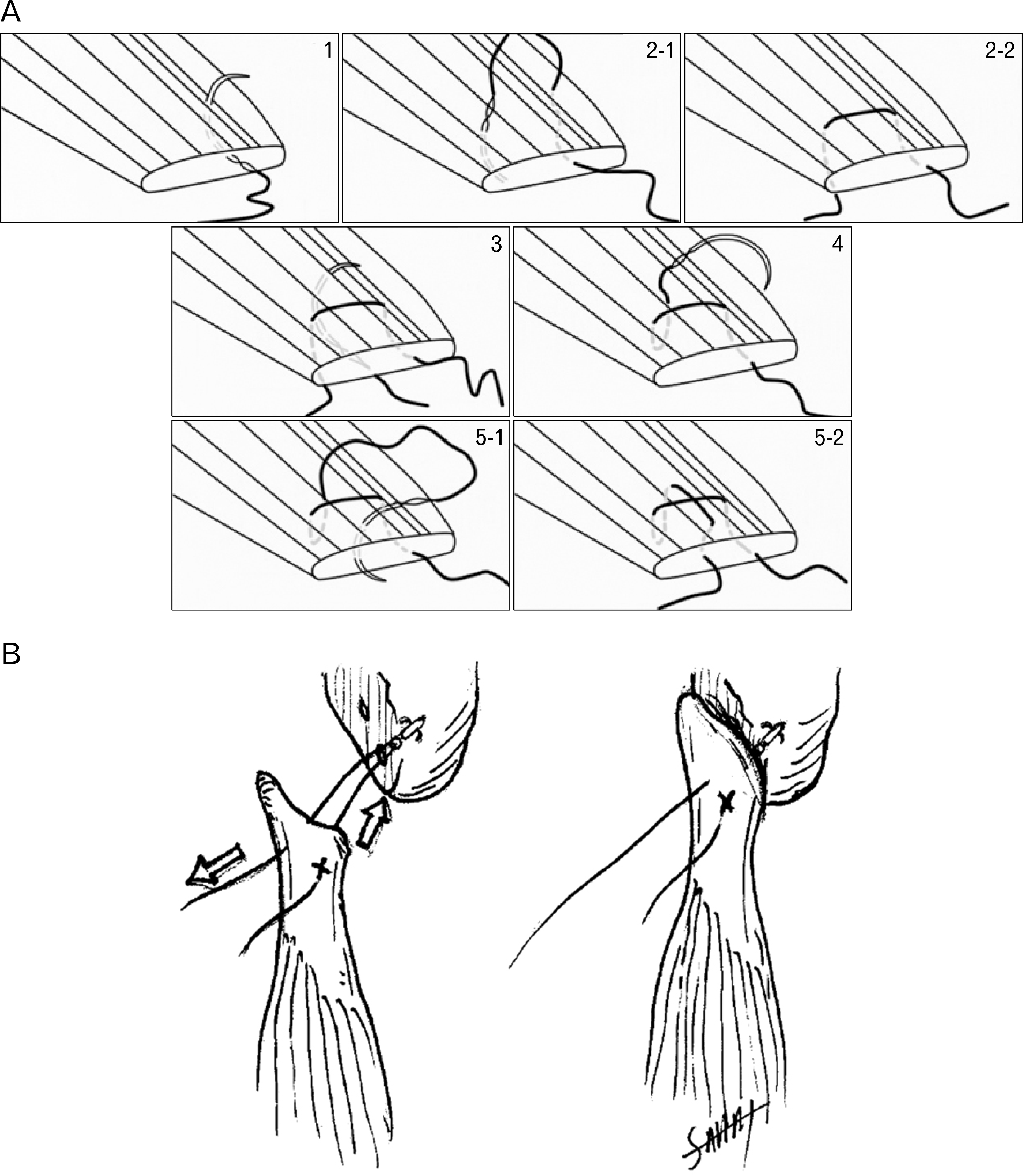Abstract
While a sprain of the hamstring muscle is relatively common in athletes or those who participate in physically active sports, a complete rupture of the proximal hamstring is relatively rare. A rupture of the long head of the biceps femoris without rupture of the semimembranosus and semitendinosus muscles has rarely been reported. In this study, we saw relatively favorable outcomes after reattachment with a suture anchor at the ischial tuberosity in two patients who had a rupture of the long head of the biceps femoris.
References
1. Floor S, van der Veen AH, Devilee RJ. Two patients with a complete proximal rupture of the hamstring. Arch Orthop Trauma Surg. 2010; 130:523–526.

2. Kwak HY, Bae SW, Choi YS, Jang MS. Early surgical repair of acute complete rupture of the proximal hamstring tendons. Clin Orthop Surg. 2011; 3:249–53.

3. Sallay PI, Friedman RL, Coogan PG, Garrett WE. Hamstring muscle injuries among water skiers: functional outcome and prevention. Am J Sports Med. 1996; 24:130–6.
4. Folsom GJ, Larson CM. Surgical treatment of acute versus chronic complete proximal hamstring ruptures: results of a new allograft technique for chronic reconstructions. Am J Sports Med. 2008; 36:104–9.
5. Sarimo J, Lempainen L, Mattila K, Orava S. Complete proximal hamstring avulsions: a series of 41 patients with operative treatment. Am J Sports Med. 2008; 36:1110–5.
6. Klingele KE, Sallay PI. Surgical repair of complete proximal hamstring tendon rupture. Am J Sports Med. 2002; 30:742–7.

7. Heiser TM, Weber J, Sullivan G, Clare P, Jacobs RR. Prophylaxis and management of hamstring muscle injuries in intercollegiate football players. Am J Sports Med. 1984; 12:368–70.

8. Chakravarthy J, Ramisetty N, Pimpalnerkar A, Mohtadi N. Surgical repair of complete proximal hamstring tendon ruptures in water skiers and bull riders: a report of four cases and review of the literature. Br J Sports Med. 2005; 39:569–72.

9. Orava S, Kujala UM. Rupture of the ischial origin of the hamstring muscles. Am J Sports Med. 1995; 23:702–5.

10. Cross MJ, Vandersluis R, Wood D, Banff M. Surgical repair of chronic complete hamstring tendon rupture in the adult patient. Am J Sports Med. 1998; 26:785–8.
Fig. 1.
(A) Coronal T2-weighted image of the left thigh at patient A. A massive hematoma is seen at the proximal part of hamstring muscle and the long head of the muscle biceps femoris is a rupture with retraction. (B) Operative image of patient A. Using three suture anchor fixation procedure on the ischial tuberosity.

Fig. 2.
(A) Coronal and sagittal T2-weighted image of the right thigh at patient B. A small hematoma is seen at the proximal part of hamstring muscle and the long head of the muscle biceps femoris is a rupture with retraction. (B) Operative image of patient B. The ruptured tendons of the long head of the muscle biceps femoris. (C) Postoperative X-ray of the pelvis of patient B. Three bioabsorbable suture anchors attached the tendons to the ischial tuberosity.





 PDF
PDF ePub
ePub Citation
Citation Print
Print



 XML Download
XML Download